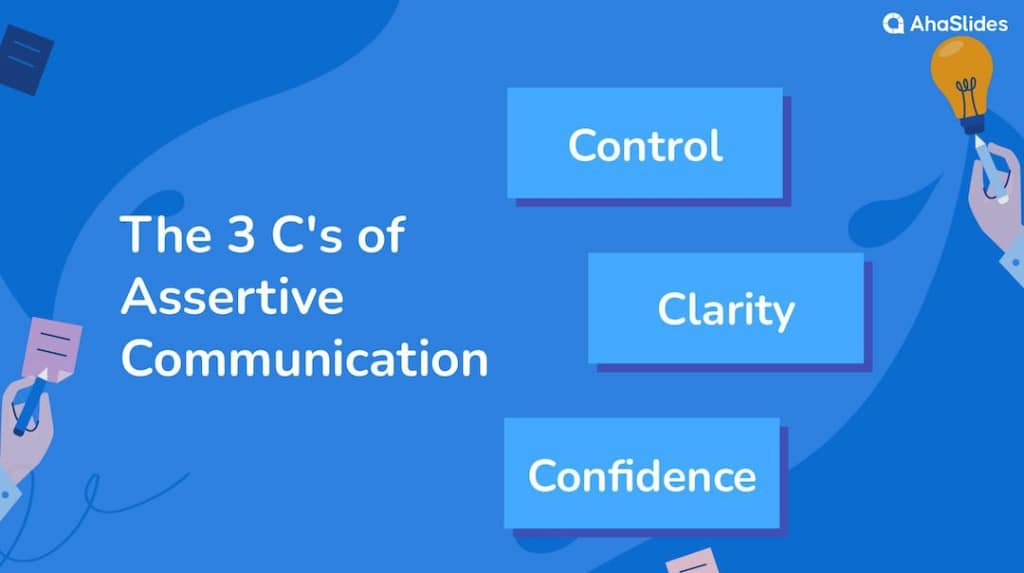How many times have you wished you had spoken up in a situation but didn't? Or felt like you let people walk all over you?
Good news - with assertiveness training, you can gain confidence in respectfully speaking your mind.
In this article, we are sharing our best tips for developing assertive communication skills. Whether you struggle to get your point across or tend to be a doormat, assertiveness is a learnable skill.

Table of Contents
- What is Assertive Communication?
- The 3 C's of Assertive Communication
- 5 Tips for Practicing Assertive Communication Skills
- Key Takeaways
- Frequently Asked Questions
What is Assertive Communication?

Assertive communication is a style of communicating where you stand up for your own rights and opinions while also respecting others.
We've all been there - a request comes your way that you're less than thrilled about. Do you cave and let resentment build? Or go nuclear with a fiery rejection? There's a better way that nurtures relationships and gets real needs met.
Passive and aggressive people either become doormats or destroy trust over time. And passive-aggressive people? Their thinly veiled jabs are below the belt. None of these styles lead anywhere good.
Assertiveness is the diplomat's approach. It acknowledges both perspectives in a dispute to find mutual understanding.
When being assertive, both parties feel heard while cooperation triumphs over conflict. Over-obliging or attacking gets you nowhere fast. Find that confident middle ground on all sides. Diplomacy gets the job done right - and relationships intact.
Related:

Looking for More Fun During Gatherings?
Gather your team members by a fun quiz on AhaSlides. Sign up to take free quiz from AhaSlides template library!
🚀 Grab Free Quiz☁️
The 3 C's of Assertive Communication
The 3'C of assertive communication are control, clarity and confidence, which provide an important framework in helping you practice your assertiveness without being perceived as overbearing or aggressive to others.

Control
In tense situations, it's easy to get flustered or say something you regret. But with practice, you can train yourself to stay cool, calm, and collected. Breathe deeply before responding. Listen actively without judgment. These small tweaks keep you in the driver's seat of any conversation.
Clarity
So many misunderstandings stem from vague or passive-aggressive language. Cut through the confusion by being directly and respectfully upfront. State your needs and views objectively using "I" statements without accusation. Leave no room for mixed messages when you speak your truth clearly.
Confidence
To assert yourself effectively means standing tall in who you are and what you bring to the table. Know your worth and speak with the assurance that comes from preparation. Have your facts straight and don't be shy about sharing your smarts. Let your body language and tone match the poise within.
5 Tips for Practicing Assertive Communication Skills
While each scenario is unique, these tips should help you hone your assertive communication skills and become an advanced diplomat:
#1. Use "I" Statements

So you find yourself routinely butting heads with coworkers or feeling unheard in meetings. Chances are, you're unintentionally placing blame on your word choice.
Saying "You do this" or "You never do that" triggers defensiveness faster than you can say "Who me?". Instead, try stripping away accusations by using "I" statements.
By expressing things from your own perspective rather than attacking others, you instantly lower the temperature.
For example, rather than spewing "You're late all the time!", try the more assertive yet diplomatic "I feel frustrated when deadlines aren't met".
People can't argue with how you truly feel inside. And they're more receptive to finding solutions when they don't feel accused. Mastering this simple "I" statement switch will save you loads of conflicts at work.
Examples:
When providing feedback:
- "I feel our team meetings could be more productive if we stayed focused on agenda items"
When asking for help:
- "I'm feeling overwhelmed with this project. Can you assist me with..."
When delegating tasks:
- "I would appreciate it if you could handle contacting clients about the deadline change"
When setting boundaries:
- "I need at least a day's notice for schedule changes to ensure I can accommodate them"
When disagreeing with a decision:
- "I disagree with that approach because in my experience..."
#2. Maintain Eye Contact

Ever feel like your message gets lost when speaking up at work? It could be due to faulty communication tactics like averting your gaze.
Eye contact, or lack thereof, speaks volumes about your confidence level. When you make solid eye contact during conversations, it demonstrates you believe in what you're saying and aren't afraid to stand by your views.
It may not feel natural at first if you're used to looking down or around the room. But maintain your gaze on the person you're talking to, and it instantly boosts your credibility.
The listener perceives you as more authoritative since you're fully engaging with them. Over time, the assertiveness from eye contact also starts to feel more authentic.
So challenge yourself on those inevitable difficult discussions ahead - muster the courage to look others in the eye.
💡Tips: Look between their eyes, not directly into the pupils, if a full gaze feels too intense.
#3. Speak Confidently with an Assured Tone

Your message deserves to be heard loudly and clearly - not mumbled into your lap! While confidence doesn’t happen overnight, you can start shifting your communication style today by focusing on how you use your voice.
Speak at a steady volume and pace when contributing to discussions or handling difficult conversations. An assured tone conveys that you believe in your perspective and have a right to be heard.
If nerves strike, take a deep breath to steady shaky words before plunging in. With practice, an authoritative voice will become your new normal.
Colleagues and clients alike are naturally swayed by individuals who project confidence through their vocal delivery. So get comfortable letting your authentic voice ring out.
Although it requires stepping outside of your comfort zone, we promise you’ll see the impact it makes. Your ideas truly do merit that boldness. Trust that your thoughtful opinions deserve an empowered platform.
#4. Suggest Solutions, Not Just Problems

We've all worked with that chronic complainer - the one who just nitpicks problems without pitching fixes.
Give me a break, right? While voicing concerns is fair, simply gripping without contributing gets old fast. As an assertive communicator, lead the positive change you wish to see.
When something's amiss, don't merely raise issues. Present potential remedies too to show you're a solution-oriented team player rather than a professional pest.
For example, if worried about a deadline's too tight, suggest reallocating tasks rather than just stressing impossibility. Your input holds more water when paired with pragmatic plans versus empty criticism.
Rather than polarising with complaints, bring people together around solutions. Compromise calms conflict as both sides work towards win-win.
Keep an open yet assured attitude inviting collaboration rather than accusation. With problems and proposals bundled together assertively, you inspire cooperation rather than ire. Start shifting from critic to career catalyst today!
Examples of how to propose solutions in the workplace:
- If projects are frequently delayed, suggest implementing a PMS to help with planning and tracking deadlines.
- If meetings often run dry, propose an icebreaker or an interactive quiz to keep everyone engaged.
- If communication between departments is lacking, recommend starting regular update meetings or a shared project documentation system.
- If the workload seems unevenly distributed, propose conducting a task audit to ensure responsibilities are clearly defined and split equitably.
- If budget overruns are a problem, suggest early cost estimations and approval checkpoints for large expenses.
- If long-term planning is lacking, offer to facilitate regular strategic planning sessions to map goals and priorities.
- If policies seem ambiguous, recommend clarifying procedures with an employee handbook or policy documentation wiki.
#5. Respect Others' Views

We've all been in one-sided conversations where the other person clearly isn't listening at all.
Sadly, we've likely done it too when our mind races ahead to what we'll say next. But master assertive communicators perfect the art of active listening - it's key to truly connecting over differences.
When others speak, put judgments aside and really try to see from their point of view. Hear out full perspectives without internally crafting rebuttals.
Notice body language and tone of voice - it all enriches understanding. Resist internal "fact-checking" statements too.
Once finished, thank the speaker for sharing. Gratitude shows you respect their viewpoint even if disagree later. People feel heard and thus more receptive to future discussions. Listening doesn't mean conceding your side either - it means cooperatively resolving issues from informed positions.
Key Takeaways
Assertiveness takes practice to develop naturally, but push past any initial discomfort - your self-advocacy and relationships will be stronger for it.
Never be afraid to diplomatically share your perspectives. And don't forget to actively listen to understand other viewpoints too.
You'll be surprised how much influence, productivity and job satisfaction will grow as a result.
Frequently Asked Questions
What are the 4 basic components of assertive communication?
Assertive communication has 4 steps: #1. the situation, #2. the feeling, #3. the explanation, and #4. the request.
What is assertive communication in communication?
Assertive communication is a style of communication that involves expressing thoughts, feelings, and beliefs in a confident and straightforward manner, while also respecting others.
What are the five barriers of assertiveness?
Five common barriers to assertiveness are: #1. Fear of conflict, #2. Low self-esteem, #3. Perfectionism, #4. Rigid thinking, #5. Lack of skills.








